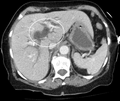Jaundice

Jaundice (also called icterus) is when the skin and the whites of the eyes become a yellow color.<ref name="mn"> Marks, Jay. Jaundice signs, symptoms and treatment(link). {{{website}}}.
</ref> People with jaundice have a problem with their liver, which stops it from removing dead red blood cells properly. These blood cells contain a chemical called bilirubin.<ref name=mn/> Bilirubin causes the yellow coloring of the skin. Jaundice is common in newly born babies. It usually starts the second day after birth.<ref name="kidshealth">
Jaundice in Healthy Newborns(link). {{{website}}}.
</ref>
Jaundice can also be caused by other diseases, like malaria, hepatitis, or gallstones.
Jaundice is the most common of all liver problems. The yellow colour of the skin and mucous membranes happens because of an increase in the bile pigment, bilirubin, in the blood.<ref name="kidshealth"/>
The bile, made by the liver, is a vital digestive fluid needed for proper nutrition. It also stops decaying changes in food. If the bile is stopped from entering the intestines there is an increase in gases and other products. Normally, the production of bile and its flow is constant.
Types of Jaundice
There are three types of jaundice:
- haemolytic jaundice - caused by destruction of red blood cells. This causes increased bilirubin formation and anaemia
- obstructive jaundice - caused by a blockage in the pathway where bilirubin is made in the liver cells and where bile goes into the duodenum
- hepatocellular jaundice - caused by damage to liver cells. The damage could be from a viral infection or toxic drugs.
Yellow discoloration of the skin and the whites of the eyes happens in all types of jaundice.
Symptoms

The symptoms of jaundice are:<ref name="js">
Jaundice signs and symptoms(link). {{{website}}}.
</ref>
- extreme weakness
- headache
- fever
- loss of appetite
- tiredness
- severe constipation
- nausea
- yellow coloration of the eyes, tongue, skin and urine.
- dull pain in the liver region.
- Obstructive jaundice may also cause intense itching.
Diagnosis
Diagnosis of jaundice typically involves:
- A physical examination to assess the extent of yellowing and look for signs of liver disease
- Blood tests to measure bilirubin levels and determine the cause of jaundice
- Imaging studies, such as ultrasound or CT scan, to evaluate the liver and bile ducts
- Liver function tests to assess the overall health of the liver
Treatment
Treatment for jaundice depends on the underlying cause. Some possible treatments include:
- Medication: For infections or liver diseases, medications may be prescribed to manage the underlying condition.
- Surgery: In cases of blocked bile ducts, surgery may be necessary to remove the obstruction, such as gallstones or tumors.
- Phototherapy: For newborns with jaundice, exposure to a special type of light helps break down bilirubin in the skin, making it easier to eliminate from the body.
- Blood transfusion: In severe cases of anemia or inherited disorders, a blood transfusion may be necessary to replace damaged red blood cells.
See also
Ad. Transform your life with W8MD's Budget GLP-1 injections from $75


W8MD offers a medical weight loss program to lose weight in Philadelphia. Our physician-supervised medical weight loss provides:
- Weight loss injections in NYC (generic and brand names):
- Zepbound / Mounjaro, Wegovy / Ozempic, Saxenda
- Most insurances accepted or discounted self-pay rates. We will obtain insurance prior authorizations if needed.
- Generic GLP1 weight loss injections from $75 for the starting dose.
- Also offer prescription weight loss medications including Phentermine, Qsymia, Diethylpropion, Contrave etc.
NYC weight loss doctor appointmentsNYC weight loss doctor appointments
Start your NYC weight loss journey today at our NYC medical weight loss and Philadelphia medical weight loss clinics.
- Call 718-946-5500 to lose weight in NYC or for medical weight loss in Philadelphia 215-676-2334.
- Tags:NYC medical weight loss, Philadelphia lose weight Zepbound NYC, Budget GLP1 weight loss injections, Wegovy Philadelphia, Wegovy NYC, Philadelphia medical weight loss, Brookly weight loss and Wegovy NYC
|
WikiMD's Wellness Encyclopedia |
| Let Food Be Thy Medicine Medicine Thy Food - Hippocrates |
Medical Disclaimer: WikiMD is not a substitute for professional medical advice. The information on WikiMD is provided as an information resource only, may be incorrect, outdated or misleading, and is not to be used or relied on for any diagnostic or treatment purposes. Please consult your health care provider before making any healthcare decisions or for guidance about a specific medical condition. WikiMD expressly disclaims responsibility, and shall have no liability, for any damages, loss, injury, or liability whatsoever suffered as a result of your reliance on the information contained in this site. By visiting this site you agree to the foregoing terms and conditions, which may from time to time be changed or supplemented by WikiMD. If you do not agree to the foregoing terms and conditions, you should not enter or use this site. See full disclaimer.
Credits:Most images are courtesy of Wikimedia commons, and templates, categories Wikipedia, licensed under CC BY SA or similar.
Translate this page: - East Asian
中文,
日本,
한국어,
South Asian
हिन्दी,
தமிழ்,
తెలుగు,
Urdu,
ಕನ್ನಡ,
Southeast Asian
Indonesian,
Vietnamese,
Thai,
မြန်မာဘာသာ,
বাংলা
European
español,
Deutsch,
français,
Greek,
português do Brasil,
polski,
română,
русский,
Nederlands,
norsk,
svenska,
suomi,
Italian
Middle Eastern & African
عربى,
Turkish,
Persian,
Hebrew,
Afrikaans,
isiZulu,
Kiswahili,
Other
Bulgarian,
Hungarian,
Czech,
Swedish,
മലയാളം,
मराठी,
ਪੰਜਾਬੀ,
ગુજરાતી,
Portuguese,
Ukrainian










